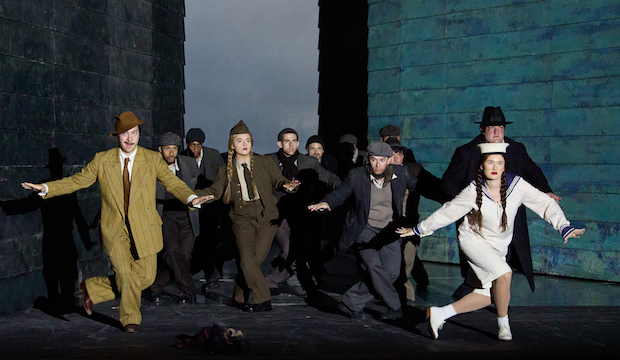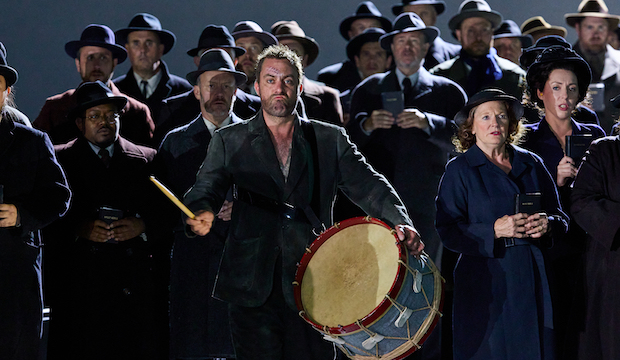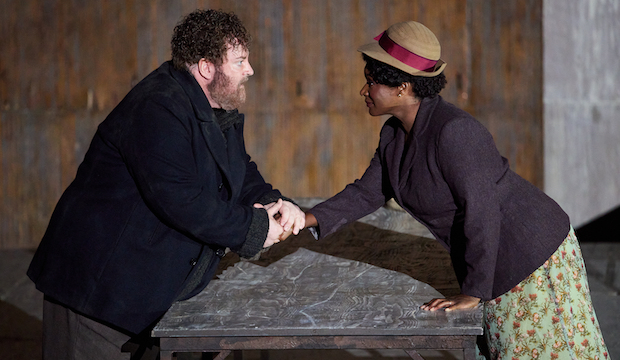Peter Grimes, English National Opera review ★★★★★
A superb production of Benjamin Britten's profound and intensely musical opera returns with a new cast
Gwyn Hughes Jones in the title role of Peter Grimes. Photo: Tom Bowles
Loss throbs through the storyline of Benjamin Britten’s Suffolk coast-set opera Peter Grimes like the pulse of the waves which are its backdrop.
A boy has died. Love is thwarted. Another boy dies. A man sails deliberately to his own death. But what moved me most on the first night of this revival of David Alden’s fine 2009 production for English National Opera? Not loss, but recovery: when the whole orchestra joined soloists and , magnificent chorus on stage for the curtain calls, the sight was overwhelming and I doubt I was the only person in the audience for whom tears welled.
Bashed and bullied by government and funding body Arts Council England, ENO has emerged stronger than ever. It is not only the music that is sung and played masterfully, but there is a tangible sense of a company working as a single, irrepressible unit, powering forward, leaving no one behind.

Alex Otterburn (left) as spivvy Ned Keene. Photo: Tom Bowles
Peter Grimes is the first of seven operas in this greatest-hits season, which also features a Marina Abramovič project and two concert performances. With Gwyn Hughes Jones in the title role, as the misfit fisherman who shocks his rigid townsfolk, it is a stupendous start to the ENO year.
Grimes has lost a boy apprentice at sea, and against advice takes on another orphaned lad. School teacher Ellen Orford best understands Grimes and loves him, as he loves her – that is, awkwardly and unfulfilled. She will keep an eye on the boy. But Grimes’s eye for a shoal unspotted by others prompts putting to sea in dangerous weather.
Swelling as implacably as the North Sea is the grim, grey wall of suspicion and distain of the Borough’s two-faced people. On the surface morally upright, they harbour dark desires that are, perhaps implausibly, visible in Alden’s reading, as townsfolk at the local dance reveal unsavoury or unsuspected sexual predilections.

David Soar as Carter Hobson, and mob. Photo: Tom Bowles
Until this moment, postwar austerity (the opera was first performed in 1945) underpins Brigitte Reiffenstuel’s costume designs and Paul Steinberg’s set, where corrugated iron and salt-washed surfaces glow brighter than the people they enclose.
Tenor Gywn Hughes Jones’s Grimes is a clumsy, lumbering giant, his frame and his intellect dwarfing those around him. While others bustle and fuss about nothing, he sings poetically of the natural world’s wonders. Soprano Elizabeth Llewellyn, to huge acclaim on opening night, is a warm Ellen Orford, and a frontline of ENO stalwarts includes bass Clive Bayley as the lawyer, whose inquest into the first boy’s death opens the opera.
As seedy Bob Boles, John Findon is ENO’s rising star, a tenor with heft, and there is characterful work from mezzo-soprano Anne-Marie Owens as Mrs Sedley and baritone Alex Otterburn as the slick spiv who feeds her drug habit. Bass-baritone Simon Bailey is particularly fine as the sea captain who has some sympathy for Grimes. David Soar as Carter Hobson leads the mob, beating out a hate-fuelled rhythm on a resounding drum.

Gwyn Hughes Jones as Peter Grimes and Elizabeth Llewellyn as Ellen Orford. Photo: Tom Bowles
But even with this line-up the outstanding performances of the evening come from the augmented chorus and orchestra of English National Opera. The Union Flag-waving, 60-plus throng of Borough-dwellers raises a wall of sound to crush the spirit, writhing like the head of Medusa and underlining its contempt for those unlike themselves with gesture. Ten actors join this heartless crowd to great effect, and Maxine Braham’s unsettling and expressive movement are completely in sync with Britten’s turbulent music.
Under ENO’s music director Martyn Brabbins, this tidal wave of vocal music ebbs and flows over the orchestral depths. The six sea interludes, of which four are much-loved concert items, here punctuate the scenes, vividly portraying the ever-changing coastline, now tranquil, now overwhelming.
At the heart of Peter Grimes are exclusion and negativity. In re-creating this production, this company has been as inclusive and positive as can be. Bravi!
Peter Grimes is sung in English with English surtitles. Performances are on 21, 23, 28 and 30 Sept; 4, 6, 9, and 11 Oct. Click here for booking, and for information about free tickets for young people
A boy has died. Love is thwarted. Another boy dies. A man sails deliberately to his own death. But what moved me most on the first night of this revival of David Alden’s fine 2009 production for English National Opera? Not loss, but recovery: when the whole orchestra joined soloists and , magnificent chorus on stage for the curtain calls, the sight was overwhelming and I doubt I was the only person in the audience for whom tears welled.
Bashed and bullied by government and funding body Arts Council England, ENO has emerged stronger than ever. It is not only the music that is sung and played masterfully, but there is a tangible sense of a company working as a single, irrepressible unit, powering forward, leaving no one behind.

Alex Otterburn (left) as spivvy Ned Keene. Photo: Tom Bowles
Peter Grimes is the first of seven operas in this greatest-hits season, which also features a Marina Abramovič project and two concert performances. With Gwyn Hughes Jones in the title role, as the misfit fisherman who shocks his rigid townsfolk, it is a stupendous start to the ENO year.
Grimes has lost a boy apprentice at sea, and against advice takes on another orphaned lad. School teacher Ellen Orford best understands Grimes and loves him, as he loves her – that is, awkwardly and unfulfilled. She will keep an eye on the boy. But Grimes’s eye for a shoal unspotted by others prompts putting to sea in dangerous weather.
Swelling as implacably as the North Sea is the grim, grey wall of suspicion and distain of the Borough’s two-faced people. On the surface morally upright, they harbour dark desires that are, perhaps implausibly, visible in Alden’s reading, as townsfolk at the local dance reveal unsavoury or unsuspected sexual predilections.

David Soar as Carter Hobson, and mob. Photo: Tom Bowles
Until this moment, postwar austerity (the opera was first performed in 1945) underpins Brigitte Reiffenstuel’s costume designs and Paul Steinberg’s set, where corrugated iron and salt-washed surfaces glow brighter than the people they enclose.
Tenor Gywn Hughes Jones’s Grimes is a clumsy, lumbering giant, his frame and his intellect dwarfing those around him. While others bustle and fuss about nothing, he sings poetically of the natural world’s wonders. Soprano Elizabeth Llewellyn, to huge acclaim on opening night, is a warm Ellen Orford, and a frontline of ENO stalwarts includes bass Clive Bayley as the lawyer, whose inquest into the first boy’s death opens the opera.
As seedy Bob Boles, John Findon is ENO’s rising star, a tenor with heft, and there is characterful work from mezzo-soprano Anne-Marie Owens as Mrs Sedley and baritone Alex Otterburn as the slick spiv who feeds her drug habit. Bass-baritone Simon Bailey is particularly fine as the sea captain who has some sympathy for Grimes. David Soar as Carter Hobson leads the mob, beating out a hate-fuelled rhythm on a resounding drum.

Gwyn Hughes Jones as Peter Grimes and Elizabeth Llewellyn as Ellen Orford. Photo: Tom Bowles
But even with this line-up the outstanding performances of the evening come from the augmented chorus and orchestra of English National Opera. The Union Flag-waving, 60-plus throng of Borough-dwellers raises a wall of sound to crush the spirit, writhing like the head of Medusa and underlining its contempt for those unlike themselves with gesture. Ten actors join this heartless crowd to great effect, and Maxine Braham’s unsettling and expressive movement are completely in sync with Britten’s turbulent music.
Under ENO’s music director Martyn Brabbins, this tidal wave of vocal music ebbs and flows over the orchestral depths. The six sea interludes, of which four are much-loved concert items, here punctuate the scenes, vividly portraying the ever-changing coastline, now tranquil, now overwhelming.
At the heart of Peter Grimes are exclusion and negativity. In re-creating this production, this company has been as inclusive and positive as can be. Bravi!
Peter Grimes is sung in English with English surtitles. Performances are on 21, 23, 28 and 30 Sept; 4, 6, 9, and 11 Oct. Click here for booking, and for information about free tickets for young people
TRY CULTURE WHISPER
Receive free tickets & insider tips to unlock the best of London — direct to your inbox
| What | Peter Grimes, English National Opera review |
| Where | English National Opera, London Coliseum, St Martin's Lane, London, WC2N 4ES | MAP |
| Nearest tube | Charing Cross (underground) |
| When |
21 Sep 23 – 11 Oct 23, Eight performances, start times vary. Running time 3hr 15min, with two intervals |
| Price | £10-£160 |
| Website | Click here for details and booking |